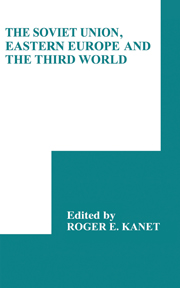Book contents
- Frontmatter
- Contents
- List of figures
- List of tables
- List of contributors
- Foreword by R.C. Elwood
- Preface by Roger E. Kanet
- PART 1 THE THIRD WORLD IN SOVIET FOREIGN POLICY
- PART 2 CMEA ECONOMIC INVOLVEMENT IN THE THIRD WORLD
- PART 3 THE SOVIET UNION IN THE MIDDLE EAST AND SOUTH ASIA
- 9 Soviet policy toward Syria in the Andropov era
- 10 Indo-Soviet security relations
- Index
- Publications from the Third World Congress for Soviet and East European Studies, Washington, 1985
10 - Indo-Soviet security relations
from PART 3 - THE SOVIET UNION IN THE MIDDLE EAST AND SOUTH ASIA
Published online by Cambridge University Press: 06 July 2010
- Frontmatter
- Contents
- List of figures
- List of tables
- List of contributors
- Foreword by R.C. Elwood
- Preface by Roger E. Kanet
- PART 1 THE THIRD WORLD IN SOVIET FOREIGN POLICY
- PART 2 CMEA ECONOMIC INVOLVEMENT IN THE THIRD WORLD
- PART 3 THE SOVIET UNION IN THE MIDDLE EAST AND SOUTH ASIA
- 9 Soviet policy toward Syria in the Andropov era
- 10 Indo-Soviet security relations
- Index
- Publications from the Third World Congress for Soviet and East European Studies, Washington, 1985
Summary
Indo-Soviet relations in the politico-security realm have flourished in part because of a lack of American willingness to help India. Significantly, the Nehru government had approached the United States in the 1950s and the 1960s to help build India's major steel projects in Bhilai and Bokaro. But Washington turned down India's requests because the projects were to be in the state sector of the economy. Again in late 1962, during India's débâcle in its border war with China, the Nehru government turned to the Kennedy Administration for assistance. While the latter responded promptly with small arms supply, Washington hesitated to comply with a subsequent Indian request for a longterm modernization of India's armed forces. The Pentagon feared that such US cooperation with the Indian armed forces would result in Pakistani retaliation in terms of closure of the US intelligence base in Peshawar targeted at the USSR. Paradoxically, Pakistan closed it down anyway a few years later. In all three cases (Bhilai, Bokaro and the Indian armed forces) Moscow was only too happy to fill the vacuum. All three today are, therefore, symbols of Indo-Soviet, rather than Indo-American friendship.
While Stalinist Russia looked upon newly independent India's nonalignment with as much suspicion as did US Secretary of State Dulles, following Stalin's demise in 1953 the Soviets were quicker to appreciate Third World nationalism and changed their Cold War perceptions and policy accordingly.
- Type
- Chapter
- Information
- The Soviet Union, Eastern Europe and the Third World , pp. 211 - 227Publisher: Cambridge University PressPrint publication year: 1988



